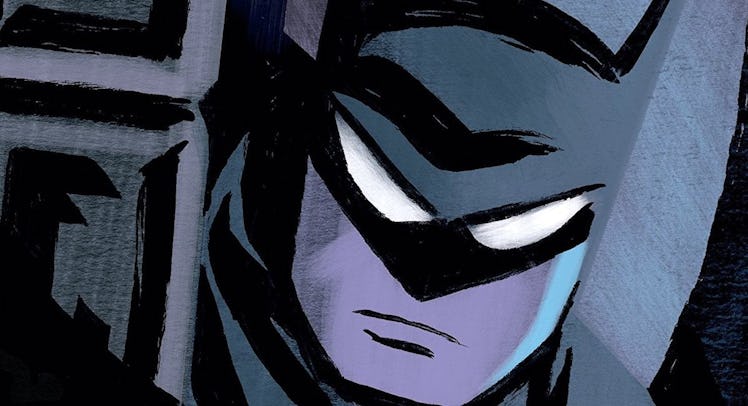This Is the One Batman Comic To Read To Really Understand Pattinson’s ‘The Batman’
In the year 2000, one Batman comic book storyline changed everything. And it's NOT the one you think.

What is Batman? There are the easy answers to that riddle of course: a superhero, the world’s greatest detective, a dark knight. All of those have their merits. But if you dig a little deeper, peel back the layers of Bruce Wayne’s mind, you’ll discover that the Batman is so much more. Something psychological? Supernatural? The death dream of a 10-year-old boy who never matured after the murder of his parents? The real answer lies in all of those theories, at least that’s what Darwyn Cooke hypothesized in his one-shot, Batman: Ego – A Psychotic Slide into the Heart of Darkness, published by DC Comics in 2000.
With the release of The Batman this week, and a few hours away for some of the most eager fans, I began contemplating what would be the one Batman story I’d recommend to those awaiting the release of The Batman, or those looking for a night cap of sorts after experiencing the film.
Naturally, there are plenty of options, many of which have been previously cited by director Matt Reeves and every other director to take on the character in the past 33 years. Batman: Year One, Batman: The Long Halloween, “The Man Who Falls,” and The Dark Knight Returns all played their part in shaping the Batmen of Burton, Nolan, and Snyder. Schumacher had his own influences, of the more camp variety, with Dick Sprang’s Batman comics of the 40s and 50s. Rather than hit on stories that have been discussed and deconstructed again and again, I turned my attention to one of the first stories The Batman director, Matt Reeves, highlighted as an influence on The Batman, and perhaps the most under-read on his list, Ego.
Shorter than many of the aforementioned stories, Ego is a psychological examination of Bruce Wayne that looks at Wayne and Batman as two separate entities sharing one body, and their war with each other following a traumatic experience. The story begins with Batman chasing down an informant, Buster Snibbs, following the Clown Prince of Crime’s killing spree that left 27 dead. Snibbs, who worked for the Joker, is on the run, and Batman believes he’s running off with money he stole from the Joker’s crime spree.
The truth is much darker. The Joker knew Snibbs ratted him out and promised that when he got out of Arkham he would make sure his family paid the price. Unable to deal with the thought of his wife and daughter dying terrible deaths at the hands of the Joker, he killed them himself. Snibbs blames Batman for the fallout, for using him and putting his family in danger, before killing himself.
One of the frequent criticisms about Batman as a character, one I’d argue stems more from those only aware of the movies rather than those well-versed in the comics, is that there’s no accountability for his actions. He may not kill, but he certainly creates the path for criminals to find themselves in a killing box. Snibbs murder of his own family forces Bruce to recall the death of his parents, but also his father’s work as a doctor, saving lives. He contemplates giving up Batman, when, a monstrous apparition of his alter-ego appears chiding him for his weakness, his doubt, his fear of doing what needs to be done to save Gotham. In terms of the rationale behind Batman’s no-killing policy, Cooke cuts to the heart of it.
Bruce knows if he gives in, sacrifices himself, and lets the Batman take over then he’d be no different from a monster like the Joker. Batman suggests they take a page from their old pal Harvey Dent, and fully embrace a dissociative identity disorder, leaving Bruce free from the weight of the actions the Batman takes. Bruce refuses to relinquish control to the Batman. He’s given another option, kill the Batman, sever himself from it completely but if he does, he does so with the knowledge that it would be suicide and that Bruce Wayne only exists, only survived the alley where his parents were killed because of the Batman.
The decision Bruce comes to is not an unexpected one, but it’s the journey of how he gets there that makes Ego such a fascinating read. And with word that The Batman will grapple with the distinction between Wayne and Batman, and if there even is such a thing, more than any of the previous films, Ego’s influence is clear. But make no mistake, Ego isn’t a dry psychological thesis essay on the character.
Cooke, who sadly passed away from cancer in 2016, got his start at DC as a storyboard artist for Batman: The Animated Series, which many, me included, consider the definitive, non-comic book take on Batman. Ego shares a stylistic sensibility with The Animated Series, giving the dark nature of the story a digestible format. By presenting itself as an “easy read,” with more cartoonish character designs, the depths to which the story goes come as a surprise, and everything to Wayne’s relationship with his parents, with death, with women, his villains and Robin is interrogated in a novel way. You’ve likely seen Batman’s parents die plenty of times, but never quite like this.
While it certainly may not look as mature as the works of Frank Miller or Dennis O’Neil, Batman: Ego is one of the most mature Batman stories, which makes it perfect for a film that shaping up to be Batman’s most mature theatrical depiction.
The Batman is out in theaters now.
Here’s the deluxe edition of Batman: Ego